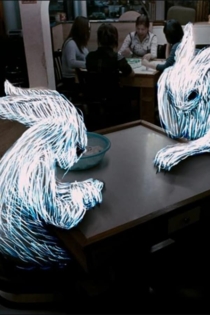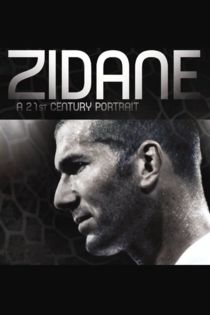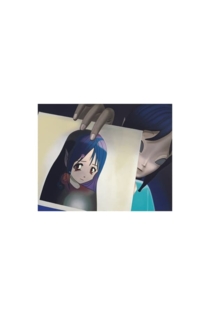
Philippe Parreno
2021Invisible Boy
Philippe Parreno
A portrait of an illegal immigrant Chinese child through the imaginary monsters that incarnate his fears and anxieties. A fiction tacked onto a reality. The reality of the illegal aliens in Manhattan’s Chinatown. People who are called ‘invisible’. This portrait gives an image to someone who doesn’t have one and, at the same time, a real person gains the social identity he’s missing by becoming a fictional character. High definition images make sensible impressions of a city as we cross over to the imaginary. Fantasy and social realism, fiction and documentary overlap. Like Superman or Spiderman, Invisible Boy is a contemporary superhero produced by the city today. His monsters appear slowly, at the beginning as scratches on the film stock, someplace in between the diegesis and the actual world. They are the boy’s superpowers. This is a tale in which a boy’s paranoia produces a topographic vision of a city.
Invisible Boy

Chew the Fat
Rirkrit Tiravanija
Angela Bulloch, Dominique Gonzalez-Foerster
"Chew The Fat" (Informal) - To have a long friendly conversation with someone. In the film project 'Chew The Fat', the artist Rirkrit Tiravanija, living in New York portraits a group of 12 artists (Douglas Gordon, Angela Bulloch, Pierre Huyghe, Philippe Parreno, Dominique Gonzalez - Foerster, Elizabeth Peyton, Tobias Rehberger, Carsten Hoeller, Liam Gillick, Jorge Pardo, Andrea Zittel, Maurizio Cattelan). The artists, all chosen by Tiravanija, belong to the same generation as himself and, like him, have advanced during the nineties to achieve international success. Most importantly, all are good friends of Tiravanija. This creates a particularly relaxed situation in which conversation can flow naturally between the two with personal issues coming up as easily and often as those to do with work or career.
Chew the Fat

Zidane, un portrait du 21e siècle
Philippe Parreno, Douglas Gordon
Zinedine Zidane
Halfway between a sports documentary and an conceptual art installation, "Zidane" consists in a full-length soccer game (Real Madrid vs. Villareal, April 23, 2005) entirely filmed from the perspective of soccer superstar Zinedine Zidane.
Zidane: A 21st Century Portrait

Anywhen In a Time Colored Space
Philippe Parreno
Anywhen In a Time Colored Space is a continuation of Philippe Parreno's Anywhen, filmed by renowned Iranian-French cinematographer Darius Khondji and featuring the voice of Nina Conti, actor, comedienne and ventriloquist. Performing the artist’s own writing integrated with fragments of James Joyce, the amalgamation of words read by Conti makes explicit Parreno’s interest in artificial, digital, and organic matter, and particularly how these forms of life communicate. The film is comprised of long sequences of a live cuttlefish (Sepia Oficinalis — a Mediterranean species of cephalopod) that can change the surface of its body—responding to outside forces such as light, sound and vibration, seemingly projecting the thoughts contained in the monologue. Much of the film focuses on the cuttlefish, which Parreno first kept in a tank in his studio.
Anywhen In a Time Colored Space

Marilyn
Philippe Parreno
A portrait of a ghost, Marilyn Monroe. The film conjures her with a phantasmagoric seance in the suite at the hotel Waldorf Astoria in New York where she lived in the 1950s. Her presence is reproduced by three algorithms: the camera becomes her eyes, a computer reconstructs the prosody of her voice and a robot recreates her handwriting. The dead is incarnated in an image.
Marilyn

Continuously Habitable Zones
Philippe Parreno
C.H.Z. ("Continuously Habitable Zones") is linked to a territory. The film gives perspective to a black garden constructed in Portugal. A landscape produced a film, and a film produced a landscape. The landscape is perennial; it is what the image rejects.
Continuously Habitable Zones

No More Reality Whereabouts
Philippe Parreno
This feature-length film combines 20 years of existing and re-edited footage to generate a 'film of films'; a hybrid that is both a non-exhaustive retrospective and the creation of a new persona through the symbiosis of its constituent parts. In the past decades, Parreno has radically redefined the exhibition experience by conceiving this as a scripted space where a series of events unfolds. Now he explores the possibilities of the theatrical film screening as a coherent ’object’ rather than a collection of individual films. For the first time, Parreno presents a retrospective of his film works in the diegetic space of the cinema instead of the museum space. Parreno proposes a 'seance of cinema’ reintroducing in this traditional setting the magic and live rituals that lie at the basis of this art form.
No More Reality Whereabouts

Stories are Propaganda
Philippe Parreno
Rirkrit Tiravanija
Stories are Propaganda was created by Philippe Parreno and Rirkrit Tiravanija for the Guangzhou Biennial in China. The artists documented the new city under construction on the Pearl River Delta near Guangzhou. A succession of fixed shots show black factory smoke, piles of trash, words written in the sand, and trees swaying in the wind. Flowing rapidly from general observations of the era to autobiographical details to self-reflection, poetic fragments unroll like snapshots: a Chinese magician making watches and clocks appear at night; a small albino rabbit floundering in a muddy puddle; a snowman made of mud; a shadow puppet silhouetted against the moon. Narrated by a child off-screen, the film creates a feeling of melancholy through its evocation of the end of the world’s ideologies. It is an inverted cinema made of scenes edited according to a temporal protocol.
Stories are Propaganda

June 8, 1968
Philippe Parreno
A film which reenacts images taken by Paul Fusco of the train voyage that transported Robert Kennedy’s corpse from New York to Washington D.C. on June 8, 1968. The film takes the point of view of the dead, a tracking shot moves through rural and urban American landscapes. People who have come to pay their respects line the tracks, staring as if in an immobile trance.
June 8, 1968

